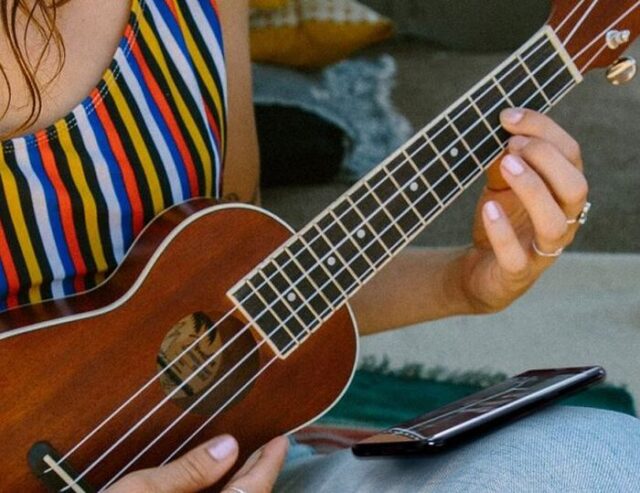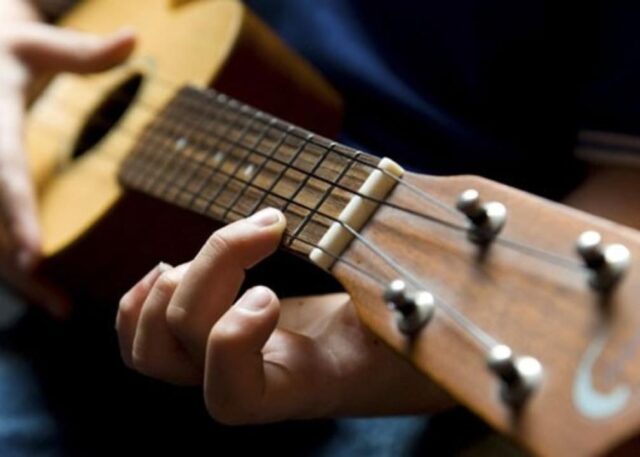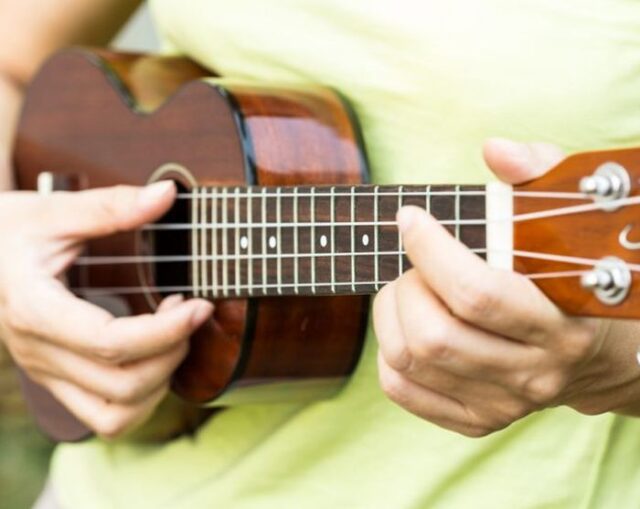
If you’re eager but unable to learn to play the ukulele because you don’t have one yet, don’t worry. There are many things you can start learning about playing the uke even if you don’t have one at hand.
These topics can even help you decide which ukulele model to get when you do get the opportunity to find the best uke for your needs and budget.
Here are some of basic ukulele lessons you can get started on today!
Ukulele Sizes and Tuning

Ukuleles come in a variety of shapes and sizes, so getting acquainted with these can help you choose the right one to get started on. There are four ukulele sizes to choose from: soprano, concert, tenor and baritone. Of the four the soprano ukulele is the smallest and it’s also a popular size for beginners, especially young children.
The three most common sizes are the soprano, concert and tenor. They have the same tuning of GCEA. The baritone ukulele has a different tuning, DGBE. It’s the same as the four highest-pitched strings on a guitar.
Ukulele Anatomy
If you are going to be playing the ukulele, you need to know its different parts. Once you have a good comprehension of ukulele anatomy, you’ll understand how one part works in relation to the another, for example the bridge and the strings. You’ll have a deeper appreciation of how ukuleles are made and you’ll also have an idea why they sound the way they do.
Reading about the parts of the ukulele can also help you build your ukulele vocabulary. This can help you follow instructions more easily.
Another benefit of learning ukulele anatomy is that it allows you to have a better idea of how a particular model is like when you’re reading ukulele specs in product reviews. This can make your buying experience more pleasant as you won’t be entirely clueless about tuning machines, saddles and strings.
Understanding Chord Diagrams
Another ukulele lesson you can get started on is reading and understanding chord diagrams. Chord diagrams or chord charts illustrate how chords are formed on the ukulele. If you know how to read and follow these diagrams, life as a beginner will be easier because you won’t be baffled with all the dots and lines you’ll see. You’ll know exactly where to place your fingers to make chords once you get ukulele in your hands.
Check out this quick tutorial on reading chord diagrams.
Basic Ukulele chords
Along with learning to read chord diagrams, you’ll also begin to learn ukulele chords. Stick to the basic or beginner chords first, such as the C, G, F, Am, D and Em chords. You know what they look like on a diagram, but how about making them yourself if you can’t practice on a ukulele? Here are a couple of ideas on learning to form these chord shapes without a uke:
- Make a ukulele ‘fretboard’ using a long piece of cardboard. Simply draw lines for the strings and frets. The measurements of the cardboard, as well as the fret and string spacing, should be similar to the ukulele size you’re eyeing. This temporary practice tool is enough to allow your fingers to get used to forming different chord shapes.
- Use an app. There are plenty of ukulele apps that can help you learn to play ukulele. There are apps that simulate a ukulele so you can practice chords and even strumming patterns. There are also apps that teach chord memorization techniques. Explore different apps to see which ones work best for you.
Rhythmic Strumming

When you play musical instruments, you need to play on the beat. If you’re the type to tap your fingers or feet or nod your head in time with the music you hear, it means you’ve got a good feel for rhythm. You need to have a good sense of rhythm in order to be able to play the ukulele because you need to strum or pick in time.
You can start learning about time signatures and practice strumming in time. Imagine playing air guitar, but a ukulele version. Fun isn’t it?
There are different strumming patterns you can practice or at least get acquainted with. Familiarizing yourself with beats and strumming patterns can make learning new songs a whole lot easier and also makes it easy for you to come up with your own tunes later on.
When you do finally get your uke, to really take your uke playing to the next level, it is advisable to get some tuition whether it be in person or online. In-person options are great and work for some but tend to be expensive and a little inflexible as there is no changing or switching up once the time for class has been set.

A more flexible option then would be learning online. There are some great options out there at the moment – some free and some not. For free courses, check out Youtube and have a delve around to see which teachers you like the most.
If you’re looking for something a little more structured, then a paid option might suit you better. You can find some great reviews here to see what options you have. Ukulele Buddy, Rocket Ukulele and many more are all offering online ukulele lessons, so be sure to read the reviews carefully before signing up and see if the course will work for you. Some will offer a trial period, so be sure to make the most of that as well.
Those are some of the ukulele topics you can read up or watch videos on today. As you can see, you don’t need to have a ukulele to start learning how to play it. Still, we’re pretty excited for you to have your own sweet little four-stringed thing so you can practice what you’ve learned today. We hope you get a real one real soon!









